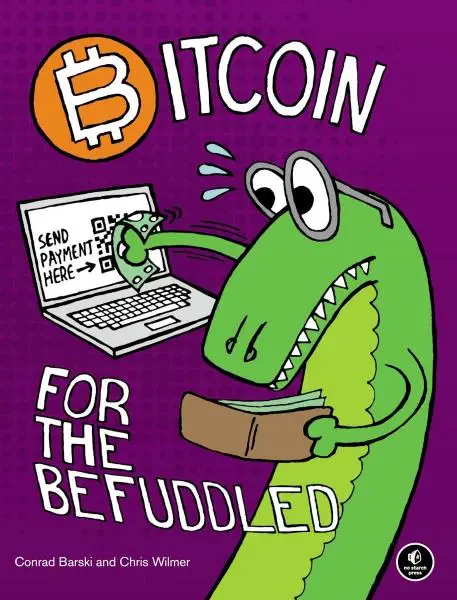Bitcoin for the Befuddled is one of my favorite books about crypto currencies. If you are a non-technical person interested in learning the important stuff about bitcoin, then this is the best book on the subject I have discovered so far. In this review I will tell you everything about this book; I hope to convince you to give it a try. If you only have time for a single book on the subject of Bitcoin, make it this one.

Bitcoin for the Befuddled was written by Conrad Barski and Chris Wilmer, and was published in 2015 by No Starch Press 1 It is richly illustrated by one of the authors (Conrad Barski) and uses the help of these illustrations — many of them featuring Crowley the Crocodile, also shown on the cover — to brilliantly explain boring and highly technical details about the blockchain, the mining process and potential uses of bitcoin.
Bitcoin for the Befuddled chooses to open with a strictly hands-on approach. It gets more technical only much later, after the reader has already become familiar with the concept of Bitcoin from a truly practical standpoint. The book starts by explaining what is Bitcoin (Chapter 1, ‘What is Bitcoin’) and how it can be used (Chapter 2, ‘Bitcoin Basics’).
Chapter 3 (‘Storing Your Bitcoins Safely, Securely and Conveniently’) guides you through the process of creating your first bitcoin wallet and teaches you how to safeguard it against theft or accidental loss.
Chapter 4 (‘Buying Bitcoins’) tells you how to buy some coins and also, and how to spend them afterwards. During my first reading of the book, at that point I was quite dissatisfied, as I thought the authors were skimming the topic and didn’t offer any in-depth explanations as to why the system works in the first place. However the richly illustrated and hilarious Chapter 5 titled ‘Lost at Sea: A Cryptographic Adventure’ made up for my frustration, and started explaining in practical terms how the different components of bitcoin work together. It explains the process of public and private keys, how the ledger operates, how transactions get verified and how double spending is prevented. It also explains the job of bitcoin miners, approximating it to producing crossword puzzles.
Chapter 6 (‘Why Bitcoin is a Big Deal’) offers a brief history of digital money and explains why all previous attempts at creating such currenices failed. It also explains how Bitcoin is different from all of them. It talks about Bitcoin author Satoshi Nakamoto and follows the development of Bitcoin for the first 4 years of its life. This is the longest chapter in the book and it concludes with an interesting and very thorough SWOT analysis of the future potential of Bitcoin. In my opinion, this chapter alone is worth the price of the book.
Chapter 7 (‘The Cryptography Behind Bitcoin’) gives a very satisfactory overview of the cryptographic mechanisms that work together to make Bitcoin unbreakable. The information in this chapter was that final piece I was missing after finishing Chapter 3. The authors handle what is a very dry and difficult to understand topic very well. Technicalities and formulas are kept to a reasonable minimum. Another series of illustrations is used to explain the principles of Elliptical Curve Cryptography and how they apply when a donut shops explodes nearby and covers your car in jelly. I am honestly not making this up.
Followed by that hilarious explanation, a more complete and technical explanation of ECC is given for those interested. The chapter concludes with an explanation as to why Bitcoin is considered so secure. It does so by trying to calculate the time needed to guess your private key when using a perfectly efficient computer operating on the Landauer limit and powered by the power of the Sun captured over a period of 100 years.
Chapter 8 (‘Bitcoin Mining’) discusses the way the blockchain is built and maintained. It talks about the Byzantine Generals’ Problem (Crowley the Crocodile is again involved) and how Bitcoin solves the trust problem. The explanations are detailed yet non-technical; they should be clear to anybody. An interesting part of this chapter is the section discussing hash rate, difficulty levels and the evolution of bitcoin mining equipment. It tries to answer the ‘mine or buy?’ question.
By conjecture, this is the most dated section of the book, as it relies on data available by the end of 2014, and because the authors have decided to make calculations in BTC, which is OK when the currency is stable but may be very confusing in periods of high fluctuations like the one we’re experiencing as I write this. But the suggested methods of calculating profitability will hold to this day, provided that you substitute performance figures with valid numbers.
The aptly numbered Chapter 8.5: The Strange World of Altcoins tries to explain the difference between Bitcoin and all of its offspring. An interesting analogy using toothpaste and shampoo in hotel rooms helps explain the continued scarcity of Bitcoin even when anybody can create an alternative crypto currency.
At first glance, Chapter 9 (‘Understanding the Different Types of Bitcoin Wallets’) seems misplaced. However the topics discussed inside (e.g. random vs determininstic key generation, offline/online signing, full vs simple payment verification…) would only make sense to the reader at this point, and not earlier. Arguably, the information in this chapter is not required reading; non-technical readers especially might decide to take a break from the book at this point. But if you are eager to know how you could integrate Bitcoin in your own business, you should read this chapter very carefully.
‘Bitcoin 2030’ is the title of Chapter 10. For this one, the authors let their imagination go wild. It is definitely a fun chapter to read, but you should take everything written in it with a huge grain of salt. Well, except maybe the part with tipping the automated lawnmower. Or the one with replacing concert tickets with colored coins. Oh, just read the whole thing, damn you!
The book also has two appendices, which discuss writing Bitcoin software. Appendix A talks about general considerations, security, good programming practices, and offers examples of a JavaScript implementation. Appendix B concentrates on using BitcoinJ for more robust applications. As this lies beyond my scope of interest, I just skimmed through it. From my quick overview, I am left with the impression that the authors have tried to cram too much information in too little space, and have additionally watered it down with extracurricular activities like setting Git and other stuff. If writing code that utilizes Bitcoin is your thing, I am told Mastering Bitcoin: Programming the Open Blockchain by A. Antonopoulos is considered the best book on the subject.
Well, that was all I wanted to say about ‘Bitcoin for the Befuddled‘! I really like this book and have re-read it multiple times. It is an easy read; it took me one Sunday afternoon to go through it for the first time. But after putting it down and returning to it a couple of months later, I was able to appreciate much better the clarity of the writing and the completeness of the coverage of this subject. ‘Bitcoin for the Befuddled’ comes with my highest recommendations, and I hope you will enjoy reading it too.

I am a small business owner from Bulgaria. I have been tinkering with personal computers ever since I was a kid. I feel enchanted by Bitcoin technology; last time I felt this excited was some 23 years ago when I first started surfing the internet using a 28.8k modem.
